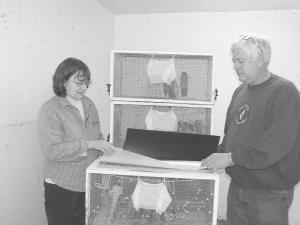2007 - Volume #31, Issue #6, Page #06
[ Sample Stories From This Issue | List of All Stories In This Issue | Print this story
| Read this issue]
Raising Insects For Agricultural Research
 |
In another 80-degree chamber, European corn borer moths survive on water in screened cages.
French and his wife, Joann, raise insects as part of their business, French Agricultural Research Inc., in Lamberton, Minnesota. Some of the insects are used on their farm for contracted research, but most are sold to 50 clients throughout the U.S. and the world. Chemical and seed companies use the insects to test the effectiveness of their products. There will always be a market for farm-raised insects because it isn't cost-efficient for companies to raise the insects themselves.
But the Frenches have to keep on top of things because of changing conditions. "For example, the Western corn rootworm beetle changed its biology four times since 1967," French explains. They have become resistant to insecticides.
Some insects are remarkably adaptive. When Minnesota producers started using crop rotation instead of growing corn year after year to eliminate the Northern corn rootworm beetle, the eggs simply sat dormant until corn was planted again - up to four years. In the East, females started laying their eggs in soybean fields, which could hatch the next year when corn was planted.
Raising insects is not as easy as it sounds. The dozen insect species the Frenches raise have different environmental needs. French, an entomologist for 40 years, says he learned to raise insects during graduate studies. The instructor thought it was important to understand the insect's whole life cycle and its environment.
In 1982, a USDA research lab asked if he'd raise insects for them. He didn't know if there would be a market, but French and his wife, a biologist/chemist, started a part-time business. There was plenty of demand; they had nearly 500 clients at one time. French made his own chambers and the couple added on to their 50 by 100-ft. facility as they could afford it. Today they have fewer clients - mostly due to companies merging - but are busy enough to hire five full-time employees plus several part-time workers during busy times.
Besides raising insects, French grows up to 4,000 test plots of corn on 300 acres, and does research and consulting work. During the political turbulence in 1995, he did "undercover work" with the World Health Organization dealing with a Western corn rootworm beetle problem in Yugoslavia.
"We stick with ag pests," French says. "We've been asked to rear many other insects, but we only rear insects that can make a profit."
He adds with a laugh that his employees tell him they are not interested in "donating blood" for mosquito research, for example.
Being successful in the business requires meticulous recordkeeping, experience raising insects and good observation skills.
"It's not about being scientific, it's the art of doing it," French says. "It takes knowledge of your surroundings. It changes with seasons." It's always important to create moisture in the atmosphere, he adds, by adding a humidifier, pouring water on the floor, or adding water to dishes of eggs.
Keeping insects alive is also not as easy as it sounds. Though shipped quickly overnight or within a couple of days overseas, hot water bottles or ice packs are added to shipments to keep temperatures at 40 to 85 degrees.
The Frenches ship insects year round, but are busiest in spring and summer. They sell the following insects in all stages from eggs to adults: four types of corn rootworms, European corn borer, black cutworm, tobacco budworm, corn earworm, fall armyworm and beet armyworm. They also raise wireworm and white grub larvae.
Contact: Lee and Joann French, French Agricultural Research Inc., 41295 County Road 54, Lamberton, Minnesota 56152 (ph 507 752-7274; lfrench@rrcnet.org; www.frenchagresearch.com).

Click here to download page story appeared in.

Click here to read entire issue
To read the rest of this story, download this issue below or click here to register with your account number.




